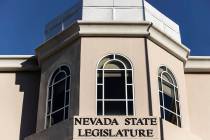Light rail for Las Vegas?
The idea of riding trains to get to Las Vegas, and get around once you’re here, isn’t really new.
But it seems recently like everybody’s talking about it more.
At the Review-Journal’s Hashtags and Headlines event last week, transportation expert Tom Skancke was all about touting rail. Foreign visitors from Europe and Asia are used to flying to a destination and hopping a train to get around, he said. And younger tech workers are more inclined to use light rail than cars, where they have to disconnect from social media and pay attention to driving.
Las Vegas Convention and Visitors Authority CEO Rossi Ralenkotter — speaking at the Las Vegas Metro Chamber of Commerce’s annual Preview event Friday — said much the same when pitching the audience on the need to increase Las Vegas’ international reach. “We are truly an international city. We need to act like it,” said Ralenkotter. “International travelers are used to landing at an airport and taking rail to where they want to go.”
Imagine if Las Vegas were to become a hub of even regional tourism: Visitors could land at McCarran on a direct flight from Europe or Asia, and then travel by train through the desert to Los Angeles, San Diego or Anaheim.
But even if those big dreams don’t come to pass right away, what about improving the way we move tourists around within Las Vegas, or help employees get to their jobs along the Strip? Light rail could work for both those things, Ralenkotter said. And the Las Vegas Monorail — which links a few Strip hotels with the Las Vegas Convention Center — could be made more useful by connecting to the Sands convention center and the Mandalay Bay Events Center, thus linking all of the city’s convention venues.
“I grew up here,” Ralenkotter said. “Nobody ever said ‘can’t.’ It was always, ‘How can we get there?’”
Rob Lang, director of Brookings Mountain West, listed creating a light-rail system among the five things he said Las Vegas needs to do to position itself for future growth. He compared Las Vegas with another tourism-dependent city, Orlando, Fla., which has a 31-mile rail system under construction and set to open in 2015. (Orlando also is more connected via highways, has a stadium and is close to the University of Central Florida, a tier 1 research institution that opened a medical school in 2006.)
Lang touted light rail in Las Vegas for its ability to encourage development close to the city center, as well as attracting high-tech workers (like Skancke, he says millennials see time spent driving as time that could otherwise be better spent connected to social media).
Of course, the question with any kind of transportation project is, how much will it cost? Lang is nothing if not pragmatic, saying “we are in one stingy state” when it comes to public support for taxes. So he’s proposed a bevy of ideas that don’t rely on taxes to pay for light rail. They include: redirecting funds from the sale of public lands in Southern Nevada; creating special tax-increment financing districts for development along light-rail tracks; or using existing federal or state road funds, since light rail would presumably take cars off local streets.
There are some hurdles, however. The Regional Transportation Commission examined light rail and elected not to pursue it, choosing buses instead. (That option was not only cheaper, but more flexible: A bus route can be changed overnight, whereas light-rail tracks are permanent.) Many ex-California residents have imported the Golden State’s car culture to Las Vegas and would be reluctant to give up their autos. And there may still be opposition from taxi and limo companies that stand to lose business if the system ran from McCarran to the Strip and downtown.
Then again, Las Vegas is changing. Maybe it’s time to take a look at an old idea that’s found purchase in Portland, Denver, Phoenix and even Orlando?
Steve Sebelius is a Review-Journal political columnist and author of the blog SlashPolitics.com. Follow him on Twitter (@SteveSebelius) or reach him at 702-387-5276 or ssebelius@reviewjournal.com.












